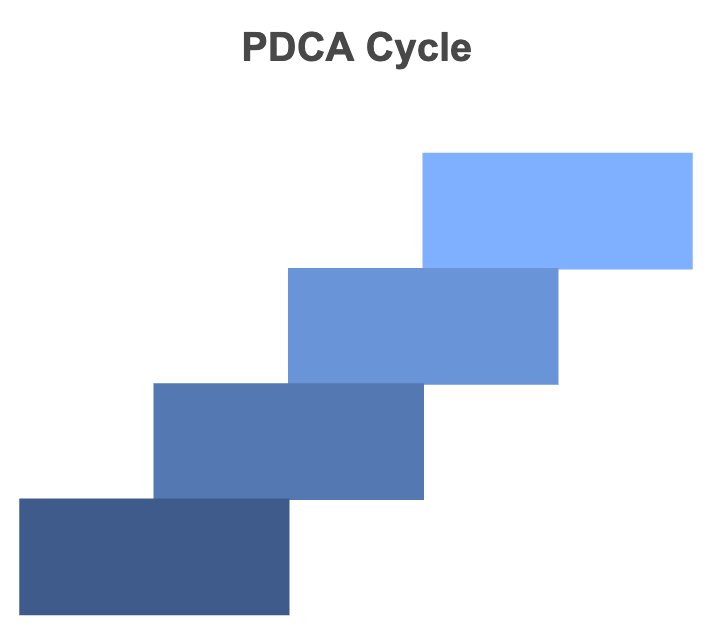Imagine having a secret weapon that could help you systematically tackle problems, implement changes, and continuously improve your business operations. That’s exactly what PDCA offers.
Whether you’re a small startup founder or a manager in a large corporation, understanding and applying the PDCA cycle can be a game-changer for your organization’s success.
In this comprehensive guide, we’ll explore every aspect of the PDCA process, from its history and core principles to real-world applications and future trends.
By the end of this post, you’ll have the knowledge and tools to implement PDCA in your own business and start reaping the benefits of continuous improvement.
What is the Plan-Do-Check-Act (PDCA) Cycle?
The Plan-Do-Check-Act cycle, often abbreviated as PDCA, is a four-step management method used for continuous improvement of processes and products. It’s a systematic approach to problem-solving and implementing change that emphasizes iterative learning and adaptation.
At its core, PDCA is about creating a culture of continuous improvement within an organization. It’s not just a one-time fix but a cyclical process that, when implemented correctly, becomes an integral part of how a business operates.

Here’s a quick breakdown of each stage:
- Plan: Identify and analyze the problem or opportunity for improvement.
- Do: Develop and implement a solution on a small scale.
- Check: Evaluate the results and identify what you’ve learned.
- Act: Take action based on what you learned, either by standardizing the solution if successful or by starting the cycle again with new insights.
Think of PDCA as a never-ending cycle of improvement. Each time you complete the cycle, you gain new knowledge and insights that feed into the next iteration, creating a spiral of continuous improvement.
The History and Evolution of PDCA
The roots of PDCA can be traced back to the early 20th century, but its evolution is a testament to the power of collaborative thinking and continuous improvement.
In the 1920s, Walter Shewhart, a physicist and engineer at Bell Laboratories, developed the concept of the Plan-Do-Study-Act (PDSA) cycle. This was the precursor to what we now know as PDCA.
However, it was W. Edwards Deming, often referred to as the father of quality management, who popularized and refined the concept. Deming’s work in post-World War II Japan, where he taught statistical process control methods to Japanese engineers and managers, laid the groundwork for the quality revolution that would transform Japanese industry.
Interestingly, the Japanese interpretation of Deming’s teachings led to the creation of the term “Kaizen,” which means “continuous improvement” in Japanese. This philosophy became a cornerstone of Toyota’s production system and later influenced lean manufacturing practices worldwide.
Over time, the PDCA cycle has been adapted and incorporated into various management methodologies, including Six Sigma, Lean Manufacturing, and Agile project management. Its simplicity and effectiveness have made it a timeless tool for organizations seeking to improve their processes and outcomes.
Breaking Down the PDCA Cycle
Let’s dive deeper into each stage of the PDCA cycle to understand how it works in practice.
Plan: Setting the Stage for Success
The Planning phase is where it all begins. This is the foundation of your improvement efforts, and it’s crucial to get it right. Here’s what you need to do:
- Identify the problem or opportunity: Clearly define what you’re trying to improve. Use data and observations to pinpoint specific issues.
- Analyze the current situation: Gather relevant data and use root cause analysis tools like the “5 Whys” or fishbone diagrams to understand the underlying causes of the problem.
- Set clear objectives: Define what success looks like. Your goals should be SMART: Specific, Measurable, Achievable, Relevant, and Time-bound.
- Develop a plan of action: Outline the steps you’ll take to achieve your objectives. Consider potential obstacles and how you’ll overcome them.
Pro tip: Don’t rush this stage. A well-thought-out plan can save you time and resources in the long run.
Do: Putting Ideas into Action
The Do phase is where rubber meets the road. It’s time to implement your plan, but with a twist:
- Start small: Implement your solution on a small scale or as a pilot project. This allows you to test your ideas without risking major disruptions.
- Document everything: Keep detailed records of what you’re doing and any observations. This information will be crucial in the Check phase.
- Train and communicate: Ensure that everyone involved understands their role and the objectives of the project.
- Be flexible: Be prepared to make minor adjustments as you implement your plan. The goal is to learn, not to execute perfectly on the first try.
Remember, the Do phase is about action and learning. Embrace the process and be open to unexpected insights.
Check: Evaluating Results and Learning
Now it’s time to step back and assess what happened. The Check phase is all about evaluation and reflection:
- Analyze the data: Compare your results against the objectives you set in the Plan phase. Use statistical tools if appropriate.
- Look for unintended consequences: Sometimes, solving one problem can create another. Be thorough in your assessment.
- Seek feedback: Talk to the people involved in the process. Their insights can be invaluable.
- Identify learnings: What worked well? What didn’t? Why? These insights will inform your next steps.
The Check phase is where the real value of PDCA starts to emerge. It’s not just about whether you succeeded or failed, but what you learned along the way.
Act: Implementing Improvements
The final stage of the cycle is where you decide what to do with what you’ve learned:
- Standardize successes: If your solution worked, implement it on a larger scale and make it the new standard.
- Address shortcomings: If the results weren’t what you hoped for, use your learnings to refine your approach.
- Communicate results: Share what you’ve learned with the broader organization.
- Plan the next cycle: Whether you’re tackling the same problem or moving on to a new one, start planning your next PDCA cycle.
The Act phase is about continuous improvement. It’s not the end of the process, but rather the beginning of the next cycle.
The Benefits of Implementing PDCA
Implementing PDCA in your organization can lead to a wide range of benefits. Here’s a table summarizing some of the key advantages:
| Benefit | Description | Impact |
|---|---|---|
| Improved Problem-Solving | Provides a structured approach to addressing issues | More efficient and effective resolution of business challenges |
| Enhanced Decision-Making | Decisions are based on data and analysis rather than gut feeling | Better outcomes and reduced risk |
| Increased Efficiency | Systematically identifies and eliminates waste in processes | Cost savings and improved productivity |
| Continuous Learning | Encourages reflection and learning from each cycle | Builds organizational knowledge and capability |
| Employee Engagement | Involves team members in the improvement process | Higher job satisfaction and motivation |
| Customer Satisfaction | Focuses on improving products and services | Increased customer loyalty and positive reviews |
| Adaptability | Promotes a culture of constant improvement | Better ability to respond to market changes |
| Quality Improvement | Systematically identifies and addresses quality issues | Reduced defects and improved product/service quality |
By embracing PDCA, organizations can create a culture of continuous improvement that drives success across all aspects of the business.
Common Challenges and How to Overcome Them
While PDCA is a powerful tool, implementing it successfully can come with its own set of challenges. Here are some common hurdles and strategies to overcome them:
- Resistance to change: Many employees may be comfortable with the status quo and resist new processes.
- Solution: Communicate the benefits clearly, involve team members in the process, and celebrate early wins to build momentum.
- Lack of leadership support: Without buy-in from top management, PDCA initiatives can fizzle out.
- Solution: Educate leaders on the long-term benefits of PDCA and show how it aligns with organizational goals.
- Insufficient data: The Check phase relies on having good data to evaluate results.
- Solution: Invest in data collection and analysis tools, and train team members on data-driven decision-making.
- Rushing through the cycle: There can be pressure to move quickly, leading to superficial analysis.
- Solution: Set realistic timelines for each phase and emphasize the importance of thorough planning and evaluation.
- Failure to complete the cycle: Sometimes organizations start strong but fail to follow through on the Act phase.
- Solution: Build accountability into the process and ensure there are clear owners for each stage of the cycle.
Remember, overcoming these challenges is part of the learning process. Each obstacle you face and overcome makes your PDCA implementation stronger.
PDCA vs. Other Improvement Methodologies
PDCA isn’t the only game in town when it comes to process improvement. Let’s compare it to some other popular methodologies:
- Six Sigma: Focuses on reducing variability and defects. PDCA is often incorporated into Six Sigma’s DMAIC (Define, Measure, Analyze, Improve, Control) process.
- Lean: Aims to eliminate waste and improve flow. PDCA complements Lean principles and is often used in Lean implementations.
- Agile: Used in software development and project management. PDCA shares similarities with Agile’s iterative approach.
- Kaizen: The Japanese concept of continuous improvement. PDCA is a structured way to implement Kaizen principles.
- Design Thinking: Focuses on innovative problem-solving. PDCA can be used to test and refine ideas generated through Design Thinking.
While each methodology has its strengths, PDCA stands out for its simplicity and versatility. It can be used on its own or integrated into other approaches, making it a valuable tool for any organization.
Real-World PDCA Success Stories
Let me share a personal experience that demonstrates the power of PDCA. A few years ago, I was working with a mid-sized e-commerce company that was struggling with high cart abandonment rates. We decided to apply the PDCA cycle to address this issue.
In the Plan phase, we analyzed data from website analytics and customer feedback. We hypothesized that the checkout process was too complicated and set a goal to reduce cart abandonment by 20% within three months.
During the Do phase, we simplified the checkout process, reducing it from five steps to three. We also added a progress bar to show customers how far along they were in the process.
In the Check phase, we monitored the results closely. After two months, we saw a 15% reduction in cart abandonment. While this was significant, it fell short of our 20% goal.
For the Act phase, we decided to build on our initial success. We surveyed customers who had completed purchases to gather more insights. Based on their feedback, we made further improvements, including adding a guest checkout option.
After another cycle of PDCA, we not only met but exceeded our original goal, achieving a 25% reduction in cart abandonment. This success led to a significant increase in revenue and demonstrated the value of PDCA to the entire organization.
This experience taught me the importance of persistence and iteration in the PDCA process. It’s not about getting it perfect the first time, but about continuous learning and improvement.
Implementing PDCA in Your Organization
Ready to bring PDCA to your organization? Here’s a step-by-step guide to get you started:
- Start with education: Ensure that key team members understand the PDCA concept and its benefits.
- Choose a pilot project: Select a small, manageable project for your first PDCA cycle. This allows you to learn and refine your approach.
- Form a PDCA team: Assemble a cross-functional team to work on the project. Diversity of perspectives can lead to better outcomes.
- Set clear objectives: Define what success looks like for your pilot project.
- Follow the cycle: Go through each stage of PDCA, documenting your process and learnings along the way.
- Reflect and adjust: After completing your first cycle, reflect on what worked well and what could be improved in your PDCA process.
- Scale up: Once you’ve refined your approach, start applying PDCA to larger projects and across different departments.
- Build a culture: Encourage all team members to think in terms of continuous improvement and to suggest areas where PDCA could be applied.
Remember, implementing PDCA is itself a process of continuous improvement. Be patient, stay committed, and you’ll see the benefits grow over time.
PDCA Tools and Techniques
To make the most of PDCA, it’s helpful to have a toolkit of supporting techniques. Here are some valuable tools for each stage of the cycle:
Plan Phase Tools:
- Root Cause Analysis (5 Whys, Fishbone Diagram)
- SMART Goal Setting
- SWOT Analysis
- Process Mapping
Do Phase Tools:
- Gantt Charts
- Standard Operating Procedures (SOPs)
- Training Materials
- Project Management Software
Check Phase Tools:
- Statistical Process Control Charts
- Pareto Analysis
- Key Performance Indicators (KPIs)
- Customer Feedback Surveys
Act Phase Tools:
- Action Plans
- Standard Work Documentation
- Change Management Techniques
- Lessons Learned Sessions
By incorporating these tools into your PDCA process, you can enhance the effectiveness of each cycle and drive more substantial improvements.
Measuring the Impact of PDCA
To truly understand the value of PDCA, it’s crucial to measure its impact on your organization. Here are some key metrics to consider:
- Process Efficiency: Measure improvements in cycle time, throughput, or other relevant process metrics.
- Quality Metrics: Track reductions in defects, errors, or customer complaints.
- Financial Impact: Calculate cost savings or revenue increases resulting from PDCA projects.
- Employee Engagement: Measure participation in improvement initiatives and employee satisfaction scores.
- Customer Satisfaction: Monitor changes in customer satisfaction scores or Net Promoter Score (NPS).
- Innovation Metrics: Track the number of new ideas generated and implemented through PDCA cycles.
- Time-to-Market: Measure improvements in how quickly new products or services are developed and launched.
- Compliance: Monitor reductions in compliance issues or audit findings.
Remember, the key is to choose metrics that align with your organization’s goals and the specific objectives of each PDCA project. Regularly review these metrics to ensure you’re capturing the full impact of your continuous improvement efforts.
The Future of PDCA in the Digital Age
As we look to the future, it’s clear that PDCA will continue to evolve and adapt to new technologies and business environments. Here are some trends shaping the future of PDCA:
- AI and Machine Learning: These technologies can help automate data collection and analysis in the Check phase, providing deeper insights and identifying patterns humans might miss.
- IoT and Real-time Data: The Internet of Things (IoT) allows for continuous monitoring of processes, enabling more responsive and data-driven PDCA cycles.
- Agile PDCA: As businesses move towards more agile methodologies, we’re seeing a fusion of PDCA with agile principles, leading to faster, more flexible improvement cycles.
- Virtual and Augmented Reality: These technologies can enhance the Do phase by allowing teams to simulate changes before implementing them in the real world.
- Blockchain for Transparency: Blockchain technology could provide a tamper-proof record of PDCA cycles, enhancing accountability and trust in the process.
- Predictive Analytics: Advanced analytics tools can help organizations anticipate problems before they occur, shifting PDCA from reactive to proactive improvement.
As an entrepreneur who’s witnessed the digital transformation of many industries, I’m excited about these developments. They have the potential to make PDCA even more powerful and accessible, enabling organizations of all sizes to drive continuous improvement.
Conclusion: Embracing Continuous Improvement
As we wrap up this deep dive into the Plan-Do-Check-Act cycle, I hope you’re as excited about its potential as I am. Throughout my career, I’ve seen PDCA transform struggling businesses into industry leaders and turn good companies into great ones.
The beauty of PDCA lies in its simplicity and adaptability. Whether you’re a startup founder trying to optimize your product-market fit, a manager looking to improve team performance, or a CEO aiming to drive organization-wide innovation, PDCA provides a framework for systematic, data-driven improvement.
But remember, implementing PDCA is not a one-time event. It’s a mindset, a commitment to never settling for “good enough.” It’s about fostering a culture where every team member is empowered to identify problems, test solutions, and drive positive change.
As you embark on your PDCA journey, keep these key takeaways in mind:
- Start small, but think big. Begin with manageable projects, but envision how PDCA can transform your entire organization.
- Embrace failure as a learning opportunity. Not every cycle will yield perfect results, but every cycle will provide valuable insights.
- Involve your team. PDCA works best when it’s a collaborative effort.
- Stay patient and persistent. Cultural change takes time, but the long-term benefits are worth it.
- Keep adapting. As your business evolves and new technologies emerge, your approach to PDCA should evolve too.
The road to continuous improvement is never-ending, but it’s also incredibly rewarding. So, are you ready to take the first step? Or if you’ve already started, are you ready to take your PDCA efforts to the next level?
Remember, in the words of W. Edwards Deming, “It is not necessary to change. Survival is not mandatory.” In today’s fast-paced business world, continuous improvement isn’t just a nice-to-have—it’s a necessity for long-term success.
TL;DR
The Plan-Do-Check-Act (PDCA) cycle is a powerful tool for continuous improvement in business.
It involves four steps: Plan (identify problems and solutions), Do (implement solutions on a small scale), Check (evaluate results), and Act (standardize successful changes or start over).
PDCA helps organizations solve problems systematically, improve processes, and foster a culture of continuous learning.
Key benefits include improved efficiency, better decision-making, and increased customer satisfaction.
While implementing PDCA can be challenging, overcoming obstacles like resistance to change and lack of data can lead to significant business improvements.
As technology advances, PDCA is evolving with trends like AI, IoT, and predictive analytics enhancing its effectiveness. Embracing PDCA is crucial for organizations aiming to thrive in today’s competitive business environment.
Q&A: Your PDCA Questions Answered
- Q: How long does a typical PDCA cycle take? A: The duration of a PDCA cycle can vary widely depending on the complexity of the problem and the scale of implementation. Simple cycles might be completed in a few days or weeks, while more complex projects could take months. The key is to move through the cycles quickly enough to maintain momentum but slowly enough to gather meaningful data and insights.
- Q: Can PDCA be used for personal development? A: Absolutely! PDCA is a versatile tool that can be applied to personal growth and development. You can use it to set and achieve personal goals, improve habits, or learn new skills. The systematic approach of PDCA can help you track your progress and continuously refine your personal development strategies.
- Q: How does PDCA differ from the scientific method? A: PDCA and the scientific method share many similarities. Both involve forming hypotheses (Plan), testing them (Do), analyzing results (Check), and drawing conclusions (Act). The main difference is that PDCA is specifically designed for business and operational contexts, with a focus on continuous improvement, while the scientific method is broader and used primarily in scientific research.
- Q: Is PDCA only for large organizations? A: Not at all! While PDCA is widely used in large corporations, it’s equally valuable for small businesses and startups. In fact, smaller organizations often find it easier to implement PDCA due to their agility and shorter communication chains. PDCA can help small businesses optimize their limited resources and compete more effectively.
- Q: How can I convince my team to adopt PDCA? A: Start by educating your team about the benefits of PDCA. Share success stories from other organizations or from your own experience. Begin with a small, manageable project to demonstrate the value of PDCA in action. Involve team members in the process and celebrate early wins to build enthusiasm. Remember, cultural change takes time, so be patient and persistent in your efforts.
PDCA Knowledge Quiz: Test Your Understanding
Take this quiz to test your understanding of the Plan-Do-Check-Act cycle. Answer each question with ‘Yes’ or ‘No’.
- Is the ‘Plan’ phase primarily about implementing solutions?
- Should you always implement changes on a large scale in the ‘Do’ phase?
- Is data analysis a crucial part of the ‘Check’ phase?
- Can you start a new PDCA cycle if your initial solution doesn’t work?
- Is PDCA only useful for manufacturing processes?
Answers:
- No – The ‘Plan’ phase is about identifying problems and developing potential solutions.
- No – The ‘Do’ phase often involves implementing solutions on a small scale or as a pilot project.
- Yes – Data analysis is crucial in the ‘Check’ phase to evaluate the results of your actions.
- Yes – If your initial solution doesn’t work, you can use the insights gained to start a new PDCA cycle.
- No – PDCA is versatile and can be applied to various business processes and even personal development.
Scoring:
- 5 correct: Excellent! You have a strong understanding of PDCA.
- 3-4 correct: Good job! You grasp the main concepts but might benefit from reviewing some details.
- 1-2 correct: You’re on the right track, but it would be helpful to review the PDCA process more thoroughly.
- 0 correct: Don’t worry! PDCA can be complex. Try rereading the article and focus on understanding each phase of the cycle.
Remember, understanding PDCA is the first step. The real learning comes from applying it in real-world situations. So, why not start your first PDCA cycle today?





